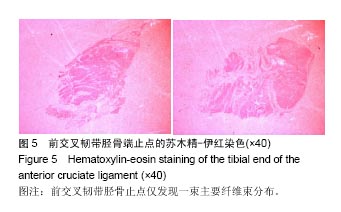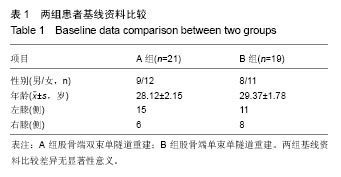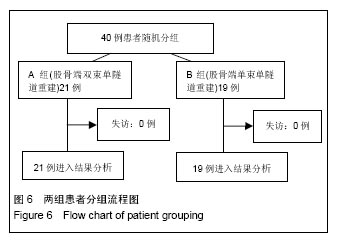中国组织工程研究 ›› 2017, Vol. 21 ›› Issue (34): 5519-5525.doi: 10.3969/j.issn.2095-4344.2017.34.018
• 材料生物相容性 material biocompatibility • 上一篇 下一篇
同种异体肌腱双束单隧道及单束单隧道重建膝关节前交叉韧带
宋 洋,蒋 欢,杜庆钧,欧定强,黄明光,曾秋涛
- 佛山市顺德区第一人民医院骨外科,广东省佛山市 528300
Double-bundle versus single-bundle anterior cruciate ligament reconstruction with allogeneic tendon via single femoral tunnel
Song Yang, Jiang Huan, Du Qing-jun, Ou Ding-qiang, Huang Ming-guang, Zeng Qiu-tao
- Department of Orthopedics, First People’s Hospital of Shunde District, Foshan 528300, Guangdong Province, China
摘要:
文章快速阅读:
.jpg)
文题释义:
前交叉韧带解剖重建:近年来越来越多的运动医学医师开始重视保留前交叉韧带未损伤的纤维束以及断裂束的残端,期望通过正常保留的纤维束以及断裂束残端促进植入物更加快速的神经再生、血管化、细胞爬行替代、腱骨愈合以及关节本体的感觉恢复。而想要达到上述的预期效果,就要将重建的区域精确的定位在正常前交叉韧带“足迹”的中心区域,这种个体化的定位方式同传统的定位方式截然不同,称之为“解剖重建”。
股骨端双束单隧道重建:通过解剖学研究发现,前交叉韧带胫骨端韧带纤维分布并未发现明显的双束结构,相反,仅发现一团唯一的韧带纤维分布致密区,这便提示:韧带通过增加密度的方式,仅分布在一个特定的区域,在这个区域中,往往占有很小面积,但占有大多数的韧带纤维。与此同时,如果能够将韧带重建的移植物定位点选择定在致密纤维分布区,那么将会代替更多的正常前交叉韧带的纤维,也就使替代正常的完整韧带行使更多的功能成为可能,因此,提出将前交叉韧带的股骨端,通过“一个骨隧道”,“两个独立纤维束”并存的方式,让移植物在股骨端尽可能多的覆盖致密纤维分布区,那么将会代替更多的正常前交叉韧带的纤维,也就使替代正常的完整韧带行使更多的功能。这就是股骨端双束单隧道重建。
背景:前交叉韧带是维持膝关节稳定结构极其重要的静力结构。许多学者发现,前交叉韧带损伤重建后效果不佳的原因之一是对前交叉韧带的正常解剖结构以及生物学特性的认识不足。
目的:比较关节镜下前交叉韧带损伤后同种异体肌腱双束单隧道重建及单束单隧道重建的疗效差异。
方法:①解剖学研究:取6个新鲜人尸的正常膝关节,每个标本均拍摄正侧位X射线,CT以及MRI,证实标本无膝关节软骨破坏、膝周肿瘤以及前交叉韧带断裂等问题。沿前交叉韧带胫骨端骨面取下前交叉韧带,苏木精-伊红染色,观察各个截段韧带的纤维分布;②临床研究:对40例前交叉韧带重建病例进行研究,其中股骨端双束单隧道重建21例,股骨端单束单隧道重建19例。术前和随访时,所有患者都需要接受Lyrsholm、Tegner评分和 IKDC2000,对比术后膝关节功能恢复情况。
结果与结论:①解剖学显示,苏木精-伊红染色未发现胫骨端存在双束的分界;②临床研究:40例患者(40个膝关节)均获得12个月以上随访,关节活动度均正常,股骨端双束单隧道重建和股骨端单束单隧道重建术后Lysholm评分、Larson评分和IKDC评分均显著高于术前;两组比较,股骨端双束单隧道重建Larson评分显著高于股骨端单束单隧道重建;③结果表明,前交叉韧带双束单隧道重建更加符合前交叉韧带胫骨端的解剖特点,可以比单束单隧道重建更好地重建膝关节的稳定性,术中操作简便,在胫骨端可较好恢复解剖重建,近期疗效佳,远期效果有待进一步观察。
中图分类号:




.jpg)
.jpg)
.jpg)
.jpg)
.jpg)